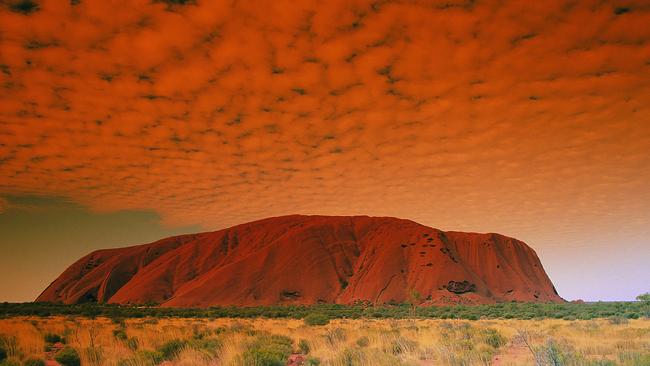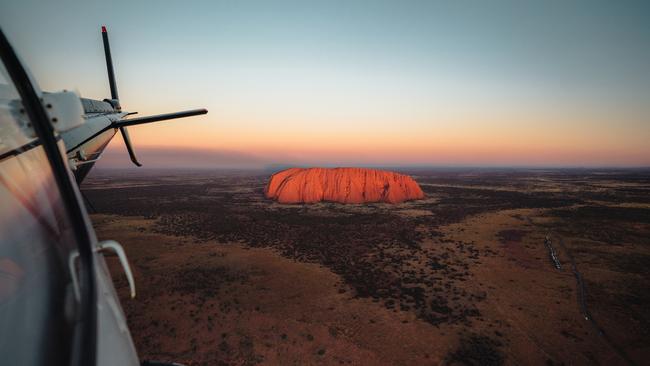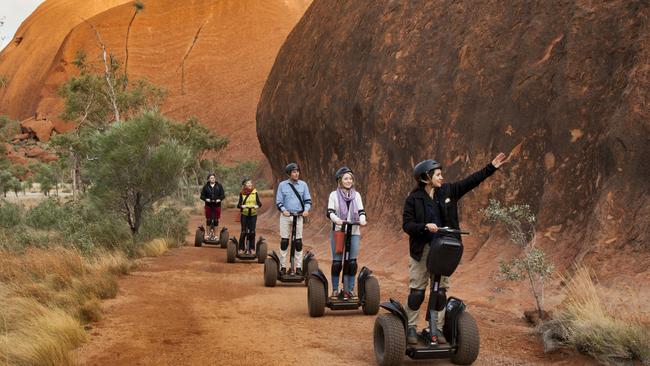Uluru: SA Weekend travel - new spin on a timeless beauty
A year since people stopped climbing to its peak, SAWeekend takes a visit back to Uluru to see what’s changed.

SA Weekend
Don't miss out on the headlines from SA Weekend. Followed categories will be added to My News.
Some things have changed in the 30 years since I took my Viking Bride to Ayers Rock for our honeymoon.
The magnificent monolith is now almost universally called by its Anangu name, Uluru; it will be a year on October 26 since the climb closed; the national park has had a name change; there are the Field of Light and Sounds of Silence experiences; and the Ayers Rock Resort complex has been substantially expanded and upgraded.
But some things don’t change. The rock is the rock is the rock. It stands, unperturbed by the passings of kings and prime ministers, pandemics and recessions, war and peace.
It continues to glow a vivid red at sunset, and equally change colours at dawn under startling blue skies.
At around 550 million years old it is about 10 million times older than me. It
is these sorts of thought that float into the mind gazing at the rock and doing what busy people seldom do: sitting and contemplating.
Our return to Uluru was straightforward. A two-hour flight to Alice Springs, then a four-hour hire car drive which allows time to start appreciating the sheer vastness of the region, its emptiness of human habitation and how, far from being the nation’s dead heart, it is alive with inhabitants.

The landscape changes as you drive past desert oaks and fields of spinifex sheltering hopping mice from dingoes, with the possibility of red kangaroos and emus.
Three feral camels standing under a shade tree looked like they were waiting for their wise men.
About 200km down the Stuart Highway, at the Erldunda Roadhouse, turn right on to the Lasseter Highway for another 268km to the rock. Sooner than expected, Uluru came into sight.
But this was “Fooluru”, the huge mesa of Mount Conner, with the real rock star still another 120km away.
Eventually, the welcome arrival at Ayers Rock Resort revealed a sprawling oasis, with accommodation including camping sites, self-contained apartments and hotels, crowned by the luxurious Sails in the Desert hotel with its lush pool and gardens area, and suites with touches such as push-button showers with dual heads.
It also has the Ilkari restaurant, the Pira Pool Bar and a shop with excellent Indigenous art and crafts.
The overall complex has a bulk-billing medical centre, petrol station and town square with supermarket, post office, bank, multiple cafes, an art gallery and retail stores. It is here that a variety of free activities is available. Learn to play the didgeridoo, go on a bush tucker foraging walk, listen to Indigenous stories or have a bush food cooking class.
But Uluru is the star attraction so late that afternoon it was down the road to Uluru-Kata Tjuta National Park for sunset (park permit needed).

At Sunset Strip, cars and campervans were lined up to watch the extraordinary changing hues as the rock glowed a fiery red before fading into darkness.
After dining at Ilkari and a comfortable night’s sleep, it was time for more rock. Thirty years ago we climbed it, because that’s just what you did, without being aware the local Anangu people were not impressed. Times have changed, with both knowledge and respect.
These days you can go around it by foot, bike or, in our case, Segway. You can also take a Harley-Davidson tour, camel rides – even a helicopter flight.
The Segway tour started with a dawn viewing of the east face, with breakfast, then a lesson on riding a Segway before setting off on the 10km trip.
Guides discuss the flora and fauna, geology, Indigenous stories and caution against taking photos at selected sites due to cultural reasons, all while you take in the different faces of this 348m-high rock with its 9.4km circumference.
You learn its origins date to the washed-down remnants of the Petermann Ranges, when they were as high as the Himalayas, crushed into rock by the weight of an inland sea, followed by geological upheavals which saw the sandstone and felspar rock rise to the surface. And that while it is weathering, it is actually growing; the surrounding plain is eroding faster to expose more of the rock, with estimates of how much is underground ranging from 1.5km to more than 5km.

The former climb site where the low assistance chain used to be bears a scar from foot traffic. The Segway tour takes in a cave art site and the almost-permanent Mutitjulu waterhole, a resource valuable beyond measure in this climate.
Other ways to enjoy Uluru and this enormous region include the Field of Light experience. In 2016, British artist Bruce Munro put in an art installation meant to last six months but it has now been extended to 2027. Some 50,000 shimmering lights in an area equal to four football fields come to life as the sun sets, thanks to 380km of optic fibres.
The effect is eerie as you walk down to it from drinks and canapes on a dune after a coach transfer from the resort – like you are flying over a city, or are entering some strange crystal city, or perhaps the brilliant night full of stars has fallen to earth.
There is also the Sounds of Silence dinner experience. Have drinks and canapes on a dune top as a didgeridoo player heralds sunset on the rock, then enjoy a bush tucker-inspired dinner.
The conversation stops as the lights go out and the lights of the night sky take over, and a “star talker” points out stars, planets, zodiac signs and more in the exceptional clarity of a night sky not polluted by city lights.
There is also a call for silence, to just drink in the sounds of the arid landscape
in the darkness while looking up at the night sky.
Like Uluru itself, this rare connection to a genuinely starry, starry night is a reminder that while many things can change in the course of three decades – or a sudden pandemic – others work on a vastly different timescale.
The writer was a guest of Voyages Indigenous Tourism Australia, which operates Ayers Rock Resort

